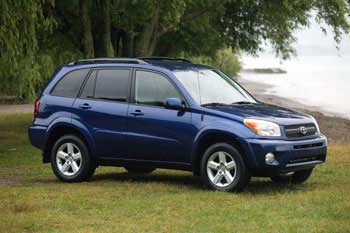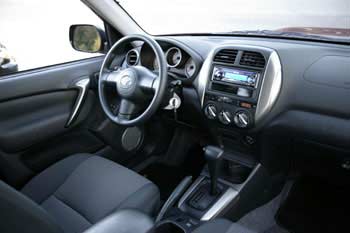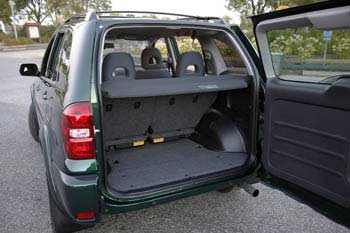Toyota RAV4 2001-2005: problems, fuel economy, driving experience, photos, maintenance tips
Updated: March 06, 2020
The name RAV4 stands for Recreational Active Vehicle with 4-wheel-drive. The RAV4 is available with front- or all-wheel drive. It rides on a car-based platform with a 4-cylinder engine and a five-speed manual or four-speed automatic transmission.
What is unique about this vehicle is that it has an optional full-time AWD system with a viscous limited-slip center differential.
 2001 - 2005 Toyota RAV4 (XA-20), (Photo: Toyota Canada)
2001 - 2005 Toyota RAV4 (XA-20), (Photo: Toyota Canada)The 2001, 2002 and 2003 RAV4 came with the 148-hp 2.0-liter 4-cylinder DOHC 1AZ-FE engine. Many owners report this engine lasting over 200K with good maintenance. Starting from 2004, the RAV4 received a 161-hp 2.4-liter 2AZ-FE engine. Overall, the RAV4 is a good little SUV, but not without problems; read details below.
Timing belt or chain Both 1AZ-FE and 2AZ-FE engines have a maintenance-free timing chain; there is no timing belt.
Toyota RAV4 problems: A faulty ECM (engine computer) in 2001-2003 models can cause problems with the way the automatic transmission shifts. The ECM needs to be replaced with an updated part to address this issue. Aftermarket parts are available, but check the ratings and reviews before buying.
An air/fuel ratio sensor is fairly common to fail, often causing the Check Engine light with the code P1155. Replacing the air-fuel ratio sensor costs $65-$320 part plus $50-$150 labor. The mass airflow sensor can get dirty causing hesitation on acceleration.
A worn-out steering rack can cause a clunking noise in the steering. Replacing a steering rack could cost from $600 to $1,000.
The hinges of the rear swing door can wear out due to lack of lubrication and heavy spare tire.
 2005 Toyota RAV4 interior. (Photo: Toyota Canada)
2005 Toyota RAV4 interior. (Photo: Toyota Canada)The difference in tire pressure or tire size can cause issues with the AWD system. It's important to keep the tire pressure up to the specs in all tires.
There are reports of stripped treads in the 2004-2005 2.4L 2AZ-FE engine cylinder block. The repair is quite expensive. Symptoms include coolant leaks on the back of the engine, overheating, misfiring at startup, running rough. We found the Toyota TSB T-SB-0015-11 on this issue that says to install Time Sert® thread repair inserts. Watch this YouTube video that shows the repair.
Inside: The RAV4's interior is simple and comfortable. High driving position offers good all-around visibility. Controls are conveniently located and easy to use. Fit and finish is good. The rear swing door glass does not open separately as in the Honda CR-V, but the low cargo floor makes loading easier. On the downside, the cargo space is limited.
Handling: The Toyota RAV4 is agile and fun to drive.
 2005 Toyota RAV4. (Photo: Toyota Canada)
2005 Toyota RAV4. (Photo: Toyota Canada)Pros: Sleek styling, available full-time AWD, versatility, fuel economy, car-like handling, fun to drive.
Cons: Front seats are not very comfortable, limited space, rear door glass doesn't open separately, lack of highway passing power, road noise, engine noise, rattles.
| Toyota RAV4 EPA Fuel Economy: | mpg city/hwy |
L/100 km city/hwy |
| 2001-2003 2WD manual | 22/28 | 10.7/8.4 |
| 2004-2005 2WD manual | 21/27 | 11.2/8.7 |
| 2001-2003 2WD auto | 21/26 | 11.2/9.0 |
| 2001-2003 4WD auto, manual | 20/25 | 11.8/9.4 |
| 2004-2005 4WD auto | 20/24 | 11.8/9.8 |
| 2004-2005 4WD manual | 19/25 | 12.4/9.4 |
Overall: The RAV4 is a rare small SUV with a full-time AWD. The cargo space is limited, but a rooftop carrier can help. Maintenance costs are low compared to other SUVs. The 2001-2003 RAV4 has a better engine.
Despite the problems mentioned above, the RAV4 overall reliability is still not too bad, considering its age. Competitors include Subaru Forester and Honda CR-V.
Related reviews:
Used Toyota RAV4 2006-2012
Toyota RAV4 2013-2018
Used Subaru Forester 2003-2008
Used Honda CR-V 2002-2006
Used Mazda Tribute 2001-2011
Used Honda CR-V 2007-2011
Used Nissan Rogue 2008-2013
Safety:
| Frontal Driver |
Frontal Pass. |
Side driver |
Side Pass. |
Rollover | |
| 2001 | n/a | n/a | |||
| 2002 | |||||
| 2003 | |||||
| 2004 | n/a | ||||
| 2005 | n/a |
What to look for when buying a used Toyota RAV4: Watch out for a blue or grey smoke or misfiring at a startup after the vehicle has been parked for a while. Usually it's more noticeable when the engine is started cold in the morning. Commonly the smoke is caused by bad valve seals. The misfiring at a startup can also be caused by a leaking head gasket. For 2001, 2002 and 2003 RAV4, you may want to check if the ECM has already been replaced with an updated part. If the "Check Engine" light is on, have the problem checked out before buying a vehicle. When test driving, make sure to check that the automatic transmission shifts properly and smoothly in all conditions. Watch out for a clunking noise coming from the steering. Read more: How to inspect a used car - illustrated guide. Have the vehicle properly inspected before buying.
AWD system: The RAV4's full-time 4WD system uses a viscous coupling center differential to distribute power to the front and rear wheels. When the front wheels start slipping, more power is transferred to the rear wheels and visa versa. The RAV4 is not a true off-roader, but its full-time AWD, light weight and compact size give this little SUV some advantage when leaving the pavement. We found plenty of Toyota RAV4 off-roading videos.
Maintenance tips: Keep your tires properly inflated, it's especially important for an AWD model.
Advertisement
You can find transmission fluid capacity in the 'Specifications' section of your owner's manual. Keep all other fluids clean and topped up. In the 4WD models, transfer case oil and rear differential oil also need to be changed regularly. If you notice any issues with the way the automatic transmission shifts, have it looked at before the problem gets worse.
Regular oil changes will help your engine last longer. When replacing a faulty ignition coil, it might be a good idea to replace all the spark plugs if they are old. When doing any repairs, it's always better to use original Toyota parts.
Have your vehicle inspected in a repair shop annually to keep it safe. You can check the maintenance schedule online at the Toyota Owners website. The same website provides access to an electronic copy of the owner's manual.
Engine oil capacity: (with filter):
2.0L (1AZ–FE): 4.4 US qt. or 4.2 liters.
2.4L (2AZ-FE): 4.0 US qt. or 3.8 liters.
SAE 5W–30 engine oil is recommended.
